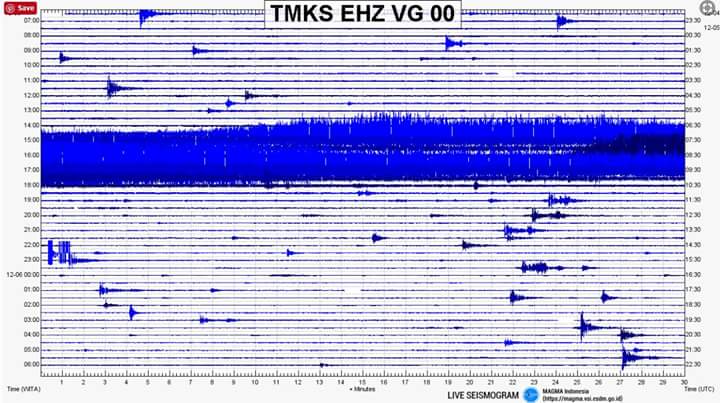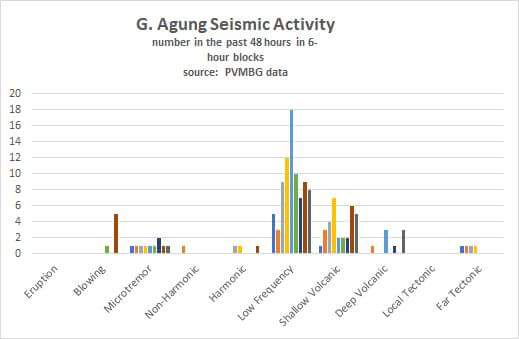6 December
Daily volcano update
- I have been taking some heat for posting links to articles by non-volcanologists or non-geologists that are being criticized by the experts. I'm an economist and a data nerd, I am NOT a volcanologist, and the whole point of this summary to provide factual (or at least credible) information. So this is a good time to re-establish the ground rules. I apologize for yesterday's lapse, and I will do my best to only include information here that is grounded in expert technical information. No more Volcano Cafe.
- We experienced a series of 2 substantial microtremors yesterday mid-day with a maximum amplitude of 24 mm (overscale). This continues pretty much a daily trend of microtremors.
- I'm still experimenting with a new data format, so the chart below will likely change. The objective is to show the types of seismic activity over the past 2 days, with the types of quakes on the right less directly linked to an eruption, and the types becoming increasingly shallow and more directly linked to an eruption as you move to the left.
- Blowing: Related to gas being expelled.
- Continuous Tremor: High intensity activity near the surface.
- Low Frequency: Movement of magmatic fluid to the surface.
- Shallow Volcanic: Shallow magma movement
- Deep Volcanic: Deep magma movement
- By the numbers, we are seeing a lot of low frequency activity, meaning magma is still moving up in the mountain. The microtremors mean magma is moving actively near the top of the volcano.
- Cameras last night showed continued glow from the crater, and there is a mostly white-ish column (indicating it's mainly from gas, not magma)
- There is no ash advisory from the Darwin VAAC, which means they don't see any. Good news for flyers.
text by Jakie Pomeroy
Daily volcano update
We experienced a series of 2 substantial microtremors yesterday mid-day with a maximum amplitude of 24 mm (overscale). This continues pretty much a daily trend of microtremors.
I'm still experimenting with a new data format, so the chart below will likely change. The objective is to show the types of seismic activity over the past 2 days, with the types of quakes on the right less directly linked to an eruption, and the types becoming increasingly shallow and more directly linked to an eruption as you move to the left.
- Blowing: Related to gas being expelled.
- Continuous Tremor: High intensity activity near the surface.
- Low Frequency: Movement of magmatic fluid to the surface.
- Shallow Volcanic: Shallow magma movement
- Deep Volcanic: Deep magma movement
- By the numbers, we are seeing a lot of low frequency activity, meaning magma is still moving up in the mountain. The microtremors mean magma is moving actively near the top of the volcano.
- Cameras last night showed continued glow from the crater, and there is a mostly white-ish column (indicating it's mainly from gas, not magma)
- There is no ash advisory from the Darwin VAAC, which means they don't see any



